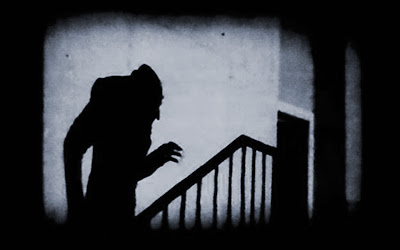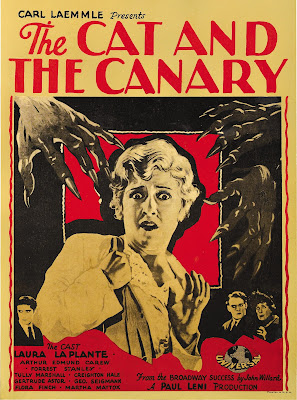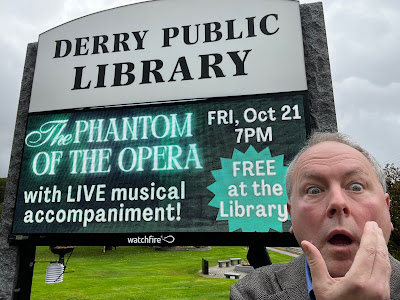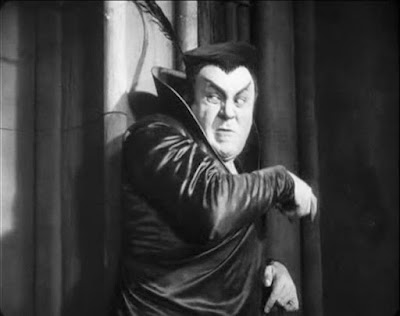My set-up at the Brattle, just before embarking on a 4½-hour journey with Fritz Lang's 'Dr. Mabuse, Der Spieler.'Well, that put the "odd" in odyssey!
I'm just back after a silent film swing that took me to screenings in Cambridge, Mass., Detroit and Cleveland, and then back again—all in less than three days.
This was all in support of this year's 'Silent Movie Day' on Thursday, Sept. 29, but which in my case also involved accompanying extra screenings on the days before and after it.
So for me, Silent Movie Day was actually three days in a row, each featuring a BIG (meaning lengthy) title.
First up: On Wednesday, Sept. 28, I left home in New Hampshire at 4 p.m. to make the one hour drive to Cambridge, Mass.
That evening, the venerable Brattle Cinema (just off Harvard Square) screened Fritz Lang's 'Dr. Mabuse, The Gambler' (1922), the sprawling two-part crime thriller that clocks in at 4½ hours. Yes, I played for it all, starting at 6 p.m. and ending just before 11 p.m.
After that, I loaded my keyboard and sound gear back onto the Forester, then hopped on the Massachusetts Turnpike (a.k.a. I-90) and headed west for Detroit, Mich. Buoyed by a brief catnap at a rest area in Utica, N.Y., I pulled into the Motor City in mid-afternoon.
At Cinema Detroit, where masks are still required out of an abundance of caution.That night (Thursday, Sept. 29), Cinema Detroit celebrated Silent Movie Day with another sprawling Lang epic, 'Woman in the Moon' (1929), with live accompaniment by me. Clocking in at 2¾ hours, it seemed like a short subject compared to 'Mabuse.'
The next day (Friday, Sept. 30), I backtracked to Cleveland, where that evening I did live music for the the Cleveland Cinematheque's screening of another silent epic: Erich von Stroheim's 'Greed' (1924).
Talk about length! Von Stroheim originally planned an eight-hour running time, and then created a four-our version before the studio finally took it from him and released a version that runs about 2½ hours, which is what we saw at the Cinematheque.
Strangely, at that length, 'Greed' turned out to be the shortest feature of the trip.
Also on the bill at Cleveland: a newly discovered industrial promotion film, 'The Heart of Cleveland' (1924), a half-hour commercial for the wonders of electricity that was filmed and shown in the city.
What a surprise! Featuring shots of a family touring giant industrial facilities, it anticipated Dziga Vertov's 'Man With The Movie Camera' by several years. More on the film (and a link to the video) is here.
The Cinematheque audience just before Friday night's screenings. Taken from the keyboard with the fisheye lens on my new iPhone 13.Afterwards, I loaded my gear and pointed the Forester east on I-90 to take me back home via the N.Y. State Thruway. After a brief catnap (again in Utica, N.Y.), I arrived home at 10:30 a.m.—exactly 66½ hours and 1,705 miles later.
Out of those 66½ hours, I was at
the keyboard improvising music for more than 10 of them. That's a lot of music to spin out in live performance over three days.
The only concession to the sheer quantity of scoring needed was that I allowed myself to use some common motifs that worked for all three films. Usually I'd try to avoid recycling material,
What motifs? The most common was a simple sequence of three descending notes: D, C#, G, with the last being held. You can build amazing things with this! (Only now do I realize it's a slight twisting of the opening notes of Rachmaninoff's very familiar 'Prelude in C# minor.')
Okay, now for the big question: Why do a stunt like this? Why combine silent film accompaniment with the romance of long-haul trucking?
Well, partly to challenge myself, and to see if I really could do it. Did I have the mental and physical stamina to get through this marathon?
Turns out I did, mostly. Only twice did I catch myself going into a mild "swoon" state on the piano bench: once near the start of Part II of 'Dr. Mabuse' (about three hours into the movie), and then near the end of 'Greed.'
Both times I felt a wave of wooziness wash over me, and so did a mental check to make sure it wasn't the symptom of some larger Fred-Sanford-like attack coming on. ("It's the big one, Weezy, I'm coming to join yez!")
In both cases, while being so absorbed in creating music, I had apparently stopped breathing. So I began breathing again, and all was well.
Otherwise, everything about this escapade fell into place quite nicely. No giant traffic delays, no car troubles, no unexpected weather.
The main cast of Fritz Lang's lunar voyage epic, 'Woman in the Moon' (1929).The only concern came at Cinema Detroit, where the heat was cranked up prior to 'Woman in the Moon,' making the house way to warm for me to survive 2¾ hours in live improv mode.
I was preparing to strategically disrobe if necessary, but they turned off the heat before the show started and all went fine.
Another reason to do this was to take advantage of 'Silent Movie Day' (which only started last year) to engineer something of a deep dive for myself: to do music for a series of longer films to see how that would affect the music-making, if at all.
I find a longer film of any type often affords enough running room to thoroughly explore whatever musical material I'm working with. With films that run two, three or four hours, you do things that just aren't possible with a film that runs an hour and change.
Counter-intuitively, I find shorter films far more demanding to score effectively, as everything's more tightly wound, especially with comedies. Often there's just no slack to lose yourself and come up with natural and effective scoring, at least the way I do it.
Talk about trances: a scene from 'Dr. Mabuse, Der Spieler.'So my mini-marathon of 10 hours was a chance to push myself as deeply as one can go into the wide open spaces of improv. And it did just that: near the end of Part 1 of 'Mabuse,' I was so completely absorbed when I realized I had no idea what the actual time was.
The Brattle has a wall clock up above where I was sitting, so I glanced up and saw: 8:35 p.m. So something like half-way through, with hours still to go. And I then dove back into the trance-like state, once again completely absorbed in translating images into music to help the film cast its spell.
I can't speak for other accompanists, but I love those rare times when a movie absorbs you so completely that you lose sight of the beginning and the end. You always know they're there, of course, but the movie is so big that both start and finish lie well beyond the horizon.
It's those times when I feel free to do what I think is my best work—where all the second-guessing subsides and the music flows naturally, as if in a dream. It's always underpinned by constant calculating and anticipation and so on, but all that becomes second nature in a way that never happens when you're playing, say, a one-reel Snub Pollard comedy.
So in terms of losing myself, I have to say I got ample doses of that with all three films. But 'Mabuse' stands out as unique, in that the sheer quantity of time to be playing live, and then knowing that I would launch myself westward in the wee hours of the morning, creating a sense of being alive and in the moment that made 'Silent Film Day' worth all the effort.
A scene from 'Dr. Mabuse, Der Spieler.'Audiences were generous with their reactions both during the screenings and afterwards. The Brattle Mabuse marathon attracted about 35 people (more than expected) who were welcomed by creative director Ned Hinkle as the "hard core."
Ned mentioned that he'd wanted to program the whole Mabuse saga in one big gulp, and the film's 100th anniversary plus Silent Film Day seemed to be the right occasion for it.
However, at first he hadn't considered live music because he couldn't imagine anyone wanting to tackle the whole thing in one evening. Little did he know!
As far as I could tell, everyone at the Brattle stayed to the end, at which point they lustily cheered the film. In fact, we seem to have ended with significantly more people than when we started.
Afterwards, I spoke with several people who had no idea they were in for such a long haul. It's one thing to see "270 minutes" in the listing, but quite another to do math.
I also talked with a young guy who turned out to be a visiting student from China who'd been in the U.S. for all of three weeks. He could not be more enthusiastic about the programming at the Brattle, which he's apparently attended every evening since his arrival.
I was glad to hear this, but couldn't help thinking he's not quite getting a very accurate impression of life in America.
At Cinema Detroit, a good-sized crowd remained engaged and reacted noisily throughout 'Woman in the Moon.' A high point was when the Walter Turner character played by Fritz Rasp does his "quick change" into another character and back again right before our eyes, which produced bursts of astonished laughter.
I think one thing that helped was that for the first time ever, I had a distinct musical signature for this character that I used only when he was on screen, and then never again except for that one moment when he reappears as if by magic.
With its one-of-a-kind mix of prescient sci-fi and completely erroneous assumptions about space travel, 'Woman in the Moon' produced the "gaping mouths" reaction that only it can do.
The one thing I forgot to mention beforehand was that although the film is a serious drama, it contains a great deal of comedy that was intended to break the tension. For modern audiences who often don't know what to make of what they're seeing, it helps to give people permission to laugh.
But the Cinema Detroit audience seemed to get this without any prompting. Several big laugh moments stand out in my mind as highlights of the communal experience.
In Cleveland, 'Greed' attracted something like 80 people, which Cinematheque director John Ewing observed was the largest in-person attendance of any screening since the pandemic.
(That's John at left, at the podium, which renders him invisible where I sit below at the keyboard.)
Fortified by a meal at 'L'Albatross,' my favorite restaurant in all of North America (no kidding!), and knowing I was in the home stretch of my marathon, I pushed myself to rise to the challenge of scoring von Stroheim's legendary lost masterwork.
And that's all I remember. Well, not really, but kinda sorta. It takes awhile to awaken from that dream state.
The next thing I knew, I was on I-90, heading east through Ashtabula, Ohio, and wondering if it had all been a dream. In other words, success!
Many thanks to the many people who made this Silent Movie Day oddysey possible, especially Ned Hinkle and Ivy Molan of the Brattle Cinema in Cambridge, Mass.; Paula and Tim Guthat at Cinema Detroit; and John Ewing and Genevieve Schwartz at the Cleveland Cinematheque.
(And a special thanks to Genevieve for joining me on the L'Albatross pilgrimage, which included visiting a side street paved with wood.)
All of these people remain willing to include silent film with live music as part of their programming—not just on Silent Movie Day, but at any time. I think that's something worth celebrating all year long.
Well...after a phenomenally busy September full of challenging live performances, I'll be taking a bit of a break now. As I said earlier this month to the audience after doing live music for Louis Feuillade's 'Les Vampires' (1915), which is 7½ hours long: "I'm going to lie down now."
But look out, as here comes Halloween! This year's schedule is highlighted by numerous screenings of 'Nosferatu' (1922) to mark the 100th anniversary of its release.
There's also a rare three-screenings-in-one-day on Saturday, Oct. 29, when I'll do 'Nosferatu' in the afternoon in Jaffrey, N.H., then 'Der Golem' in the evening in Ogunquit, Maine, and then a midnight screening of the reconstructed 'London After Midnight' at the Coolidge Corner Cinema in Brookline, Mass.
One day, three screenings, three states.
Anyone want to book a morning screening in Rhode Island that day to make it four?
If we start at 6 a.m., we can fit in the entire 'Dr. Mabuse' saga, with plenty of time for lunch...































